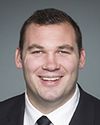Yes, I'm happy to expand on that.
Within the agriculture equipment industry, there are a variety of manufacturers. One of them was asked to produce a larger tractor from a seeder. A seeder is a piece of equipment that looks like a spider. It precisely puts the seed in, followed by the fertilizer. This is using GPS. It's an amazing piece of technology. The seeders are getting bigger, so the seeder manufacturers asked a variety of tractor manufacturers if they could build bigger tractors, because once the machinery hit hills, the tractors were sticking and not able to continue pulling. From that perspective, applications have been made.
What I know of this situation is that the SR and ED auditors didn't understand the importance of a 400-horsepower tractor. They said it wasn't new, wasn't innovative.
I am a farmer. I have run a combine and I've used our GPS systems, and they are great. They ensure that we seed as we think and that we don't duplicate by going over it. The 400-horsepower tractor is what enables us to get to that next piece of equipment. Without something that can pull the seeder, you can't use the seeder. That was a bit of a disconnect, because as I understand it, all the auditor has said is that it's simply a larger tractor. That one larger piece of equipment enables so much more throughout modern farming.
Again, I will offer to take you out to farms, to take you to ag equipment manufacturing facilities, because there are some really important, seemingly small steps that enable the leaps and bounds, which is how we can feed the world.



